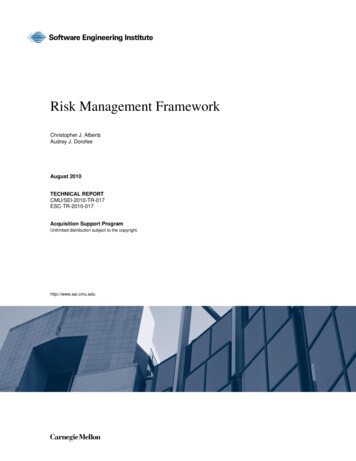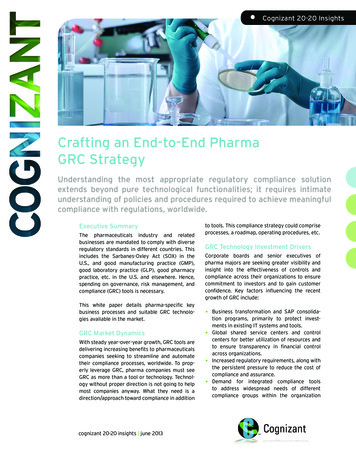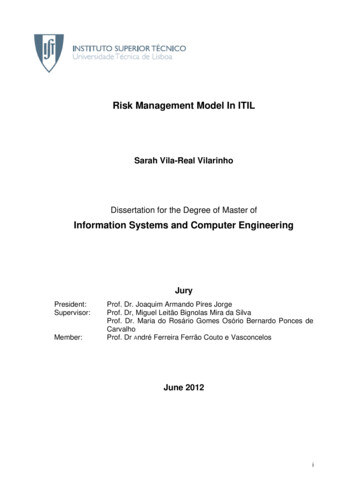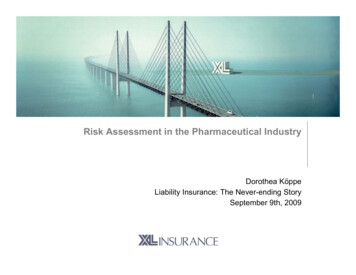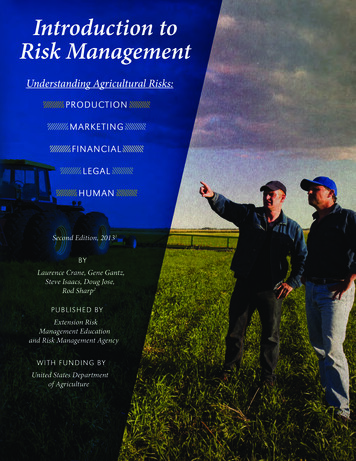
Transcription
Introduction toRisk ManagementUnderstanding Agricultural Risks:PRODUCTIONMARKETINGFINANCIALLEGALHUMANSecond Edition, 20131BYLaurence Crane, Gene Gantz,Steve Isaacs, Doug Jose,Rod Sharp2PUBLISHED BYExtension RiskManagement Educationand Risk Management AgencyWITH FUNDING BYUnited States Departmentof Agriculture
Overview of RiskManagement PlanningContentsOverview of RiskManagementPlanning.1Steps in RiskManagementPlanning.2ManagingProduction Risk.8ManagingMarketing Risk.15ManagingFinancial Risk.23ManagingLegal Risk.30ManagingHuman Risk.35Credits.40Risk can be defined as the chance of loss or an unfavorable outcomeassociated with an action. Uncertainty is not knowing what willhappen in the future. The greater the uncertainty, the greater therisk. For an individual farm manager, risk management involves optimizingexpected returns subject to the risks involved and risk tolerance.Agricultural producers make decisions in a risky environment every day.The consequences of their decisions are generally not known when thedecisions are made. Furthermore, the outcome may be better or worse thanexpected. The two situations that most concern agriculture producers are:1) is there a high probability of adverse consequences, and 2) would thoseadverse consequences significantly disrupt the business?Risk is what makes itpossible to make a profit.If there was no risk, therewould be no return tothe ability to successfullymanage it.Risk is what makes it possible tomake a profit. If there was norisk, there would be no return tothe ability to successfully manageit. For each decision there is arisk-return trade-off. Anytimethere is a possibility of loss(risk), there should also be anopportunity for profit. Growersmust decide between different alternatives with various levels of risk. Thosealternatives with minimum risk may generate little profit. Those alternativeswith high risk may generate the greatest possible return but may carry morerisk than the producer will wish to bear. The preferred and optimal choicemust balance potential for profit and the risk of loss. It all comes down tomanagement, and there are no easy answers.This handbook is designed to improve the risk management skills ofAmerican farmers and ranchers. There is a broad array of establishedrisk management tools ready to be used and new tools are always beingdeveloped. By learning about and using these tools, crop and livestockproducers can build the confidence needed to deal with risk and excitingopportunities of the future.Overview of Risk Management Planning1
Section1Steps in RiskManagement Planning1 I D E N T I F Y R I S K SThe first step in the process of managing risk is identifying and classifyingthe prospective risks. The five primary sources of risk are: Production,Marketing, Financial, Legal and Human.PRODUCTION RISKAgricultural productionimplies an expected outcomeor yield. Variability in thoseoutcomes poses risks to yourability to achieve financialgoals. Any production relatedactivity or event that has arange of possible outcomes isa production risk. The majorsources of production risksare weather, climate changes,pests, diseases, technology, genetics, machinery efficiency, and thequality of inputs. Fire, wind, theft, and other casualties are also sources ofproduction risk.The major sources ofproduction risks areweather, climate changes,pests, diseases, technology,genetics, machineryefficiency, and thequality of inputs.MARKETING RISKMarketing is that part of a farm business that transforms productionactivities into financial success. Agriculture operates in a global market.Unanticipated forces anywhere in the world, such as weather orgovernment action, can lead to dramatic changes in output and inputprices. When these forces are understood, they can become importantconsiderations for the skilled marketer. Marketing risk is any marketrelated activity or event that leads to the variability of prices farmersreceive for their products or pay for production inputs. Access to marketsis also a marketing risk.FINANCIAL RISKFinancial risk encompasses those risks that threaten the financial healthof the business and has four basic components:1) The cost and availability of capital;2) The ability to meet cash flow needs in a timely manner;3) The ability to maintain and grow equity;4) The ability to absorb short-term financial shocks.2Steps in Risk Management Planning
Cash flows are especially important because of the variety of on-goingobligations such as cash input costs, cash lease payments, tax payments,debt repayment, and family living expenses.LEGAL RISKMany of the day-to-day activities of all farmers involve commitmentsthat have legal implications. Understanding these issues can lead tobetter risk management decisions. Legal issues intersect with other riskareas. For example, acquiring an operating loan has legal implicationsif not repaid in the specified manner. Production activities involvingthe use of pesticides have legal implications if appropriate safetyprecautions are not taken. Marketing of agricultural products caninvolve contract law. Human issues associated with agriculture alsohave legal implications, ranging from employer/employee rules andregulations, to inheritance laws. The legal issues most commonlyassociated with agriculture fall into five broad categories:1) Contractual arrangements;2) Business organization;3) Laws and regulations;4) Tort liability; and,5) Public policy and attitudes.HUMAN RISKPeople are both a source of business risk and an important part of thestrategy for dealing with risk. At its core, human risk managementis the ability to keep all people who are involved in the business safe,satisfied and productive. Human risk can be summarized into fourmain categories:1) Human health and well-being;2) Family and business relationships;3) Employee management; and,4) Transition planning.2 MEASURE RISKSProbabilities are simply a way of expressing the chance of variousoutcomes occurring. Weather forecasts use probabilities. For example,they may indicate a 20 percent chance of rain or a 40 percent chanceof snow. Some probabilities are known objectively by observation ormeasurement. Some probabilities must be subjectively estimated by thedecision maker.Steps in Risk Management Planning3
Variability of outcomes is generally associated with risk, and riskiersituations typically have greater variability of outcomes. The averageoutcome is the most frequent or most likely if outcomes are normallydistributed, but the average does not provide information aboutvariability. The range, the highest and lowest possible values, combinedwith the average does provide some information about variability.However, it is difficult to make comparisons of variability betweenagricultural enterprises or prices.The probabilities of outcomes translate into the financial impact ofthose various possible outcomes. For example, the probability of aspecific crop yield will result in a specific net income. Measuring risksincludes an assessment of the probabilities of the possible outcomesand the impact of each outcome.3 ASSESS RISK BEARING CAPACITYRisk management strategies are also affected by an individual’s capacityor ability to bear (or to take) risk. Financially, risk bearing capacity isdirectly related to the solvency and liquidity of one’s financial position.Risk bearing ability is also affected by cash flow requirements. Thisincludes the obligations for cash costs, taxes, loan repayment, andfamily living expenses that must be met each year. The higher theseobligations are as a percentage of total cash flow, the less able thebusiness is to assume risk. The best source of historical production andmarketing information is the records maintained for the business. Therecords may be supplemented and complemented by information fromoutside sources. But there is no substitute for actual historical data.4 EVALUATE RISK TOLERANCE OR PREFERENCESPeople may be categorized into one of three broad types of risktolerance. Risk averse producers are the most cautious risk takers.They are willing to give up some income to some level of avoid risk.They may value safety, stability, or financial survival more than anopportunity for higher profits.Risk neutral producers understand they must take some chances to getahead, but recognize that there are degrees of risk in every situation.Before making a decision or taking action they gather information andanalyze the odds and seek to maximize incomeRisk preferring individuals enjoy risk as challenging and excitingand look for the chance to take risks. Some producers may be in thiscategory with respect to their marketing plans, even though they maynot consciously plan to take on market risk . They may enjoy the4Steps in Risk Management Planning
adventure of playing the market. Pure speculators are typically in thiscategory.5 SET RISK MANAGEMENT GOALSA meaningful goal is specific, measurable, attainable, challenging butrealistic, time specific, written, and performance based. If one achievesall conditions of a specific measurable goal, confidence increases andsatisfaction results. If a measurable goal is not attained, objectiveanalysis can occur and adjustments can be made to improve thelikelihood of success.Care should be taken to set goals over areas where one has as muchcontrol as possible. Nothing is as discouraging and counterproductiveto goal setting as failing to achieve a goal for reasons beyond yourcontrol. If goals are set on performance or skills to be acquired, thencontrol over achievement is maintained.There are beneficial reasons to set goals:1) To reflect the values, interests, resources and capabilities ofeveryone involved in the business;2) To provide a basis for all business and family decisions;3) To set priorities for the allocation of scarce resources; and,4) To measure progress.Steps in Risk Management Planning5
6 IDENTIFY EFFECTIVE RISK MANAGEMENTTOOLSBecause of the multiple sources of risk, comprehensive strategies thatintegrate several responses to variability are often necessary for effectiverisk management. The particular combination used by an individualfarmer will depend on the individual’s situation, the types of risk faced,and the risk attitudes or preferences. Some risk responses such asvaccinations, preventative maintenance, feed inventories, and irrigationact primarily to reduce the chance that an adverse event such as disease,breakdown, and drought will occur. Other responses have the effectof providing protection against adverse consequences by transferringsome of the risk to someone else such as insurance and forward pricing.Producers find many different ways to implement these principal riskresponses. Tools are discussed for each of the five areas of risk later inthis manual.7 SELECT PROFESSIONAL ASSISTANCEEven though risk management is challenging, there are manyprofessional resources available and farmers should not feel isolated.Extension educators and university extension specialists are trained toprovide educational programs and leadership to help implement theplanning process. Insurance agents, crop and livestock consultants,livestock nutritionists, marketing specialists, lenders, attorneys andothers are available and well qualified to help with risk managementplanning, depending upon the specific need.Many of these professionals have a stake in the farm business andhave an incentive to provide objective information and feedback onalternative strategies. The regular use of a business advisory teamkeeps the business fine-tuned and on the cutting edge. Be judiciousin selecting professional help. Ask for references and credentials asappropriate. Rely on the experience of other growers, input suppliers,implement dealers, peer groups, allied professionals, trade associationrecommendations, and trusted friends and mentors.8 MAKE A DECISION AND IMPLEMENT THE PLANPossibly the most difficult aspect of any decision process isimplementing the plan. Following through the steps provides theconfidence and numerical measurements to implement a plan that bestfits the situation.6Steps in Risk Management Planning
9 EVALUATE THE RESULTSInclude a mechanism to collect the results of the plan, compare with theexpected outcomes and make plans for adjustments, if necessary, forfuture decision cycles.OVERALL RISK MANAGEMENT PLAN CHECKLIST:Have the primary sources of risk been identified and classified?Have the risk outcomes and their likelihood or probability ofoccurring been estimated?Has the financial capacity of the business or ability to bear risk beenevaluated?Have the risk tolerances of the business operators been considered?Are risk goals written and are they specific, measurable, attainable,relevant, and timed?Have the goals been shared with everyone involved in the business?Have risk tools and strategies been identified to help manage riskswhich could prevent achieving established goals?Has a confident relationship been established with a team of riskmanagement advisors, so they can help assess and manage businessand personal risk exposure? 2013 COMMUNITY CROPS, LINCOLN, NESteps in Risk Management Planning7
Section2ManagingProduction RiskAny production related activity or event that is uncertain is aproduction risk. Agricultural production implies an expected outcomeor yield. Variability in outcomes from those expected creates risks toyour ability to achieve financial goals.Growers have three choices in dealing successfully with production risks.1) They can control or minimize risk through managementpractices by doing a better job of what they currently do.2) They can reduce production variability by making changes suchas diversifying, integrating, applying new technology, etc.3) They can transfer production risk to someone else throughcontracting, purchasing insurance, etc.For decades agriculturalrisk was synonymouswith crop productionrisk. Reducing variabilityin expected yields hasbeen a major focus ofrisk management. Overtime, improvements intechnology and cropproduction practices have helped decrease agronomic risks andincrease yields. For example, genetic engineering has produced newplant varieties that are disease and drought resistant; commercialfertilizers have increased yields; effective herbicides and insecticideswere developed controlling weeds and insects; and, a whole hostof improved production and management practices have beendisseminated. Not only is yield variability still a formidable productionrisk, but the consolidation of agriculture is also impacting the entireagricultural production sector. These structural shifts mean thatfarmers are vulnerable not only to the vagaries of weather, but are alsovulnerable to external economic forces that exacerbate traditionalproduction risks.Over time, improvementsin technology and cropproduction practices havehelped decrease agronomicrisks and increase yields.STRATEGIES FOR MANAGEMENTFarmers have three choices in dealing with production risks.8Managing Production Risk
The first is to continue farming or ranching as before, but try to controlor minimize risk through management practices. This includes suchthings as timeliness in performing operations, practicing preventativemaintenance, and monitoring production activities more closely toensure problems are detected early enough to take corrective measures.The second choice is to reduce production variability. Generally, thismeans reconfiguring the operation by adding or changing enterprisesthrough diversification or integration, and applying improvedtechnology as appropriate. Remaining flexible is essential to being ableto respond to changing economic conditions more easily. A big partof reducing production variability is to actively plan for the future andprepare a contingency plan for undesirable events.The third alternative in managing production risk is to transfer someor all of the risk to someone else. Contracting and insurance are twoeffective tools to transfer risk.1 CONTROL OR MINIMIZE RISKThere are numerous examples of how risk can be minimized orcontrolled through improved management practices. Chemical andfertilizer use can help to control or reduce the variability in production.Irrigation is very effective in minimizing the effects of low rainfallor drought. Health and nutrition programs can reduce variability inlivestock production.Timeliness of operations has a large impact on most productionactivities. It is often the key to success.Managing Production Risk9
Practicing preventative maintenance is also a method of managingproduction risks by minimizing the likelihood of negative events takingplace. Many risks are difficult to anticipate. The use of basic control andfeedback strategies is important.2 REDUCE VARIABILITYDIVERSIFICATIONDiversification is an effective way of reducing income variability.Effective diversification occurs when low income from one enterprise isoffset by satisfactory or high incomes from other enterprises. It typicallyreduces large year-to-year variations in income and may ensureadequate cash flow for meeting production costs, debt obligations, andfamily living needs. However, acquiring knowledge about an alternativebusiness, expertise on new crop production practices, or informationon equipment for a new crop may be costly. Expanding into new areasor experimenting with new enterprises will increase capital investmentrequirements. For instance, diversification can include different planttypes, different combinations of crops and services, different endpoints in the same production process such as different selling sizes, ordifferent varieties of the same plant.Through crop diversification, growers may initiate another marketing10Managing Production Risk
method, providing a way to enhance profitability. For example, directmarketing of the diversified crop to consumers is becoming morecommon, including farmers’ markets, roadside stands, and communitysupported agriculture arrangements.The benefits of diversifying income sources depend on the variabilityof returns faced by a producer. Diversification to help counter negativefluctuations in farm income can also be achieved by having severalincome sources, such as additional on-farm businesses, custom hireservices, off-farm employment, investments or savings.FLEXIBILITYFarmers commonly attempt to maintain flexibility in the use offarm assets and operating procedures as a production response tothe variability. Increasing specialization of production facilities andequipment limits flexibility among enterprises. Growers are morelikely to maintain flexibility in their marketing and financial decisionsthan in the type and size of production activities. The costs associatedwith flexibility in production need to be compared with the potentialbenefits.INTEGRATIONVertical integration includes all of the ways that output from one stageof production is transferred to another. For example, a nursery thatprovides landscaping services using their own nursery stock is verticallyintegrated.To a certain degree, vertical integration runs counter to the conceptof specialization. The early farms of pioneer settlers were in essencetotally vertically integrated. Every aspect of the production process wasconnected and performed on the single farm. Contemporary farmsare a blend of integration and specialization. For example, a dairyfarm may integrate feed production, milk production, and replacementheifer production. It may also integrate into the production andsale of finished products through direct or traditional retail markets.However, some dairy farmers may specialize to greater degree on milkproduction and elect to purchase all of their feed and replacementheifers. Integration depends on market opportunities, assets available,and the skills and knowledge of the managers.APPLY TECHNOLOGYThere are countless opportunities to apply new technology in managingproduction risk on the farm. This includes the physical technologyoften referred to as precision agriculture. Precision agriculture takesadvantage of advances in computers and mechanical engineering tomake better, more efficient, machines and equipment.Managing Production Risk11
Biotechnology research continues to advance on many fronts withthe goal of making crop production more efficient. Scientists aredeveloping plant varieties that can withstand environmental stressessuch as drought, flood, frost, or extreme temperatures. A related areaof research is adapting crops to regions where they are not normallygrown because of climate, altitude, or rainfall. Biotechnology is alsobeing used against plant pests such as weeds, insects, and diseases.Biotechnology is being used to develop diagnostic tests for a wide rangeof diseases and viruses.The key to applying technology in managing risk is to do so in a waythat lowers total farm risk. Sometimes new technology may increaserisk, or the increased cost for the corresponding reduction in risk isprohibitive.3 TRANSFER RISK TO SOMEONE ELSECONTRACTINGA contract is usually defined as a written or oral agreement betweentwo or more parties involving an enforceable commitment to door refrain from doing something. In agriculture, contracts betweenfarmers and agribusinesses specify certain conditions associated withproducing and/or marketing an agricultural product. By combiningvarious market functions, contracting generally reduces participants’exposure to risk. In addition to specifying certain quality requirements,contracts also can specify price, quantities to be produced, and servicesto be provided.Growers enter into contracts for various reasons, including incomestability, improved efficiency, market security, and access to capital.Retailers enter into contracts to control input supplies, improveresponses to consumer demand, and expand and diversify operations.All of these reasons reflect efforts to bring a more uniform product tomarket.Production contracts can take many forms, depending upon thecommodities being contracted and the economic needs of theparties entering into the contract. Generally, producers give up somemanagement independence and decision making for a more stableincome and less variability.12Managing Production Risk
INSURANCEInsurance can be an effective mechanism of transferring large risksto someone else. To be insurable, an adverse event must be importantenough to cause economic hardship to the insured if it occurs. Further,there must be a sufficient number of adverse events or potential qualityloss to allow a reasonably close calculation of the probable loss. Also,the potential loss must be accidental and unintentional and whenan adverse event occurs, the amount of loss must be observable andmeasurable.By definition, insurance is the means of protecting against unexpectedloss. The risk can be passed off by purchasing insurance from aninsurance company, or it can be self-insured. With self-insurance thereare no premiums to pay, but in the event of a loss, the operator bearsthe full amount of the loss.The three types of insurance that all operators should carry are:1) Property and casualty insurance;2) Health, life, and disability insurance; and,3) Liability insurance.Crop insurance is a very important type of property insurance thatcan be used very effectively in conjunction with marketing plans toalso reduce marketing risk. Crop insurance can guarantee a level ofproduction, thus removing the risk associated with forward pricingor selling products that are yet to be produced. Crop insurance willprovide the money to deliver on a commitment should the insuredcrop suffer a loss prior to harvest. Through the effective use of cropinsurance, producers can enhance their financial management andsecure operating loans.Medical expenses due to an illness or injury can wreak economichavoc on a family. Farmers are more likely to be disabled than killed inaccidents. A good disability policy is as important as life insurance andis a good risk management tool.A liability policy protects a farmer against claims or lawsuits broughtby persons whose property or person has allegedly been injured by thefarmer’s negligence.Managing Production Risk13
PRODUCTION RISK MANAGEMENT CHECKLIST:What are your major sources of crop and livestock production risk?Are the knowledge and management capabilities available to diversifyor add another enterprise? Is there a strong level of commitment todiversify?What are the income and risk relationships between a prospective newenterprise and existing enterprises? Will the new enterprise provideeffective diversification?What are the implications of a crop loss on the ability to meet debtobligations and cash flow needs?Which crop insurance product(s) and coverage offer the best protectionfor the coverage needed? Which coverage will best complement themarketing plan?Are there no cost or low cost practices that can be implemented tocontrol or minimize risk?Is contracting a viable method of transferring risk? What are the legalconditions and implications of contracting?What are the economic benefits and risks of adopting new technologies?14Managing Production Risk
Section3ManagingMarketing RiskMarketing is the activity that transforms production in a farm or ranchoperation into financial success. To deal with marketing risk, it isessential to understandTo deal with marketing risk, how markets function,prices areit is essential to understand howdetermined and thehow markets function, how tools that are availableto take advantage ofprices are determined andopportunities.the tools that are availableto take advantage ofopportunities.Uncontrollableevents includingconsumer preferences,weather, government actions, the factors affecting the price of othercommodities and currency values all have a dramatic impact on thecrop and livestock markets. These factors apply both to our domesticsituation and the global circumstances. Agriculture markets areincreasingly global markets, necessitating an understanding of globaleconomic conditions to make prudent marketing decisions.MARKETING PLANSGiven the volatility of the markets, preparing and following a marketingplan can be an elusive task. However, a marketing plan is an integralcomponent of the goals of the business, the management philosophy,and the overall business plan for the operation. That business planshould also include production, financial, and personnel managementplans.A marketing plan sets specific actions to be taken and the steps neededto accomplish the business goals. It requires:1) an understanding of the alternatives and the tools the businesswishes to use;2) analysis of the alternatives; and3) the discipline to follow through.Managing Marketing Risk15
MARKETING PRINCIPLESThe Marketing Chain for agricultural products includes productionof the raw good, assembly, processing, wholesaling, retailing, andconsumption. Each step enhances the desirability of the good to theconsumer by producing value in form, place, time and possession.The form value results from having the product in the form for theconsumer to gain maximum value from its consumption. The placevalue depends on having the product where the consumer wants it. Thetime value comes from having the product available to consumers whenthey want it. The possession value comes from transferring physicalpossession and ownership in the manner the consumer desires. In oureconomic system, prices are set in the marketplace. Understandinghow the market values form, place, time and possession enhances theseller’s ability to take advantage of the market opportunities. Deliveringthe product with the characteristics that have the greatest value in themarketplace is a key marketing principle.Price Elasticity of a product is the sensitivity of the demand for theproduct to changes in price. Traditionally, the demand for agriculturalproducts has been relatively inelastic. That is, there is little change in thequantity demanded with changes in price.THE COMPONENTS OF MARKETING DECISIONSThere are six basic decisions with each marketing action. These are:1) When to price or sell.This decision requires determining the time when the pricewill be established. This could be at delivery or at another time.2) Where to price or sell.Typically there are a number of alternatives, some throughdirect selling and some through contracting.3) What form, grade or quality to sell.Some commodities are more sensitive to quality factors thanothers while other commodities may not have establishedquality standards.4) How to price.This involves choosing among various alternative tools ormechanisms to set the price.5) What services to use.There may be specific services offered by agribusinessassociates.16Managing Marketing Risk
6) When and how to deliver.This often is directly linked to how the price is set.Transportation and storage costs need to be considered in themarketing decision.MARKETING DISCIPLINEMarketing Discipline is often the most difficult aspect of marketing.Establishing goals and putting them in writing is an immense helpin maintaining the discipline needed in marketing decisions. Othertechniques to maintain discipline include discussing the marketing planwith business partners, open and frequent communication with marketadvisors, and a long-run view of marketing. These actions couldalso create more confusion and reduce confidence but by conductingthe discussions with the original goals in mind, it can reinforce thediscipline needed.Contingency plans, as part of the basic marketing plan, will also help.This provides a pre-determined plan if the market situation changes.What to do if the price does not meet expectations and what to do if thecrop is not as large as expected are important contingency actions.The bottom line in marketing plans i
business is to assume risk. The best source of historical production and marketing information is the records maintained for the business. The records may be supplemented and complemented by information from outside source







